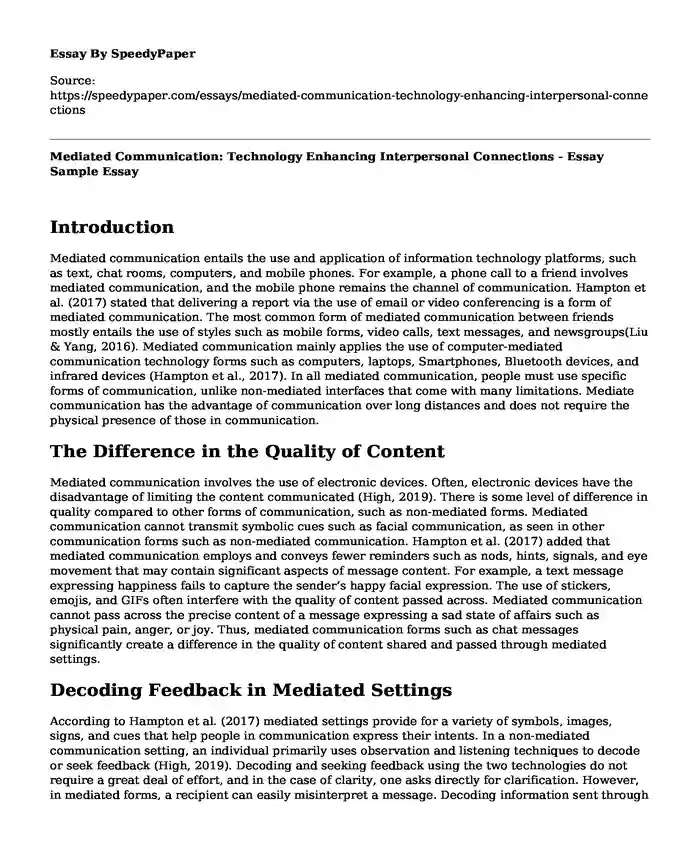
| Type of paper: | Essay |
| Categories: | Communication Technology |
| Pages: | 4 |
| Wordcount: | 868 words |
Introduction
Mediated communication entails the use and application of information technology platforms, such as text, chat rooms, computers, and mobile phones. For example, a phone call to a friend involves mediated communication, and the mobile phone remains the channel of communication. Hampton et al. (2017) stated that delivering a report via the use of email or video conferencing is a form of mediated communication. The most common form of mediated communication between friends mostly entails the use of styles such as mobile forms, video calls, text messages, and newsgroups(Liu & Yang, 2016). Mediated communication mainly applies the use of computer-mediated communication technology forms such as computers, laptops, Smartphones, Bluetooth devices, and infrared devices (Hampton et al., 2017). In all mediated communication, people must use specific forms of communication, unlike non-mediated interfaces that come with many limitations. Mediate communication has the advantage of communication over long distances and does not require the physical presence of those in communication.
The Difference in the Quality of Content
Mediated communication involves the use of electronic devices. Often, electronic devices have the disadvantage of limiting the content communicated (High, 2019). There is some level of difference in quality compared to other forms of communication, such as non-mediated forms. Mediated communication cannot transmit symbolic cues such as facial communication, as seen in other communication forms such as non-mediated communication. Hampton et al. (2017) added that mediated communication employs and conveys fewer reminders such as nods, hints, signals, and eye movement that may contain significant aspects of message content. For example, a text message expressing happiness fails to capture the sender’s happy facial expression. The use of stickers, emojis, and GIFs often interfere with the quality of content passed across. Mediated communication cannot pass across the precise content of a message expressing a sad state of affairs such as physical pain, anger, or joy. Thus, mediated communication forms such as chat messages significantly create a difference in the quality of content shared and passed through mediated settings.
Decoding Feedback in Mediated Settings
According to Hampton et al. (2017) mediated settings provide for a variety of symbols, images, signs, and cues that help people in communication express their intents. In a non-mediated communication setting, an individual primarily uses observation and listening techniques to decode or seek feedback (High, 2019). Decoding and seeking feedback using the two technologies do not require a great deal of effort, and in the case of clarity, one asks directly for clarification. However, in mediated forms, a recipient can easily misinterpret a message. Decoding information sent through mediated setting requires more intuition, sense, and intellect than messages sent via other forms of communication(Liu & Yang, 2016). Thus, there is a significant difference in decoding and seeking feedback in mediated settings, as misinterpretation and misunderstanding remain high (Hampton et la., 2017). Decoding and seeking feedback in other forms remains secure, and one can make in-depth inquiries with ease. Mediated settings often have complex interpretation scenarios that may affect or impact the quality of communication, thus bringing forth a significant level of difference in structure, framework, and situational setting.
Behaviors to Employ
Mediated settings often pose various limitations in communication, especially in passing across explicit content. At the same time, mediated contexts may present various complications in passing across some meaningful information such as facial cues and symbols (High, 2019). Unlike non-mediated communication, a mediated setting may require high-level adjustment strategies to improve communication. First, one has to make good use of the various features such as emojis, GIFs, and images to express them comprehensively. Second, it is essential to apply and use the features within their right context and framework (Hampton et al., 2017). Thirdly, messages should remain short, to the point, and with clear objectives. Other important points to note include upholding objectivity all through a conversation, avoiding “online grenades,” and establishing the appropriate tone to prevent misinterpretations (Liu & Yang, 2016). Lastly, it is essential to use the proper device for fitting communication.
As technology usage expands and forms the primary aspect of communication, mediated communication will remain the standard of communication. Mediated communication entails the use and application of various forms of communication devices. They include chat forums, video conference forums, text messaging, and mobile calls. Mediated settings offer strategic platforms for passing and exchanging information. However, they have multiple drawbacks regarding the quality of content conveyed and how a party can decode and seek feedback for messages exchanged. A person must thus apply various strategies to improve and adjust communication in mediated settings. Some of the approaches include using an appropriate device, using provided features appropriately, and packaging messages correctly. Mediated communication is an essential strategy of communication, easing and enabling communication over long distances and enhancing interactions.
References
Hampton, A. J., Rawlings, J., Treger, S., & Sprecher, S. (2017).Channels of computer-mediated communication and satisfaction in long-distance relationships. Interpersona: An International Journal on Personal Relationships, 11(2), 171-187.https://129.237.36.133/hct/article/download/11977/11370
High, A. (2019). Theorizing a More Complete Picture: Integrating Interpersonal Communication with Computer-Mediated Communication. Human Communication & Technology, 1(1), 22-26.https://129.237.36.133/hct/article/download/11977/11370
Liu, D., & Yang, C. C. (2016). Media niche of electronic communication channels in friendship: A meta-analysis. Journal of Computer-Mediated Communication, 21(6), 451-466.https://academic.oup.com/jcmc/article/21/6/451/4161803
Cite this page
Mediated Communication: Technology Enhancing Interpersonal Connections - Essay Sample. (2023, Aug 26). Retrieved from https://speedypaper.net/essays/mediated-communication-technology-enhancing-interpersonal-connections
Request Removal
If you are the original author of this essay and no longer wish to have it published on the SpeedyPaper website, please click below to request its removal:
- Technology Essay Example: Wireless Networks
- Essay Sample on Social Media and Business Marketing
- Essay Sample on Impacts of Globalization on a Software-Producing Company
- Paper Example. Piloting Digital Devices
- An Overview of Fashion E-commerce - Paper Sample
- Essay on Wireless Technology: Utilizing Air for Data Transmission
- Free Essay Sample: Applying Strategies to Achieve Competitive Advantage
Popular categories




